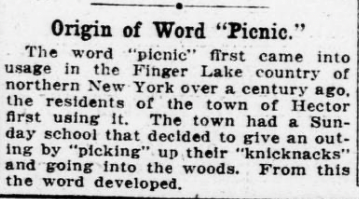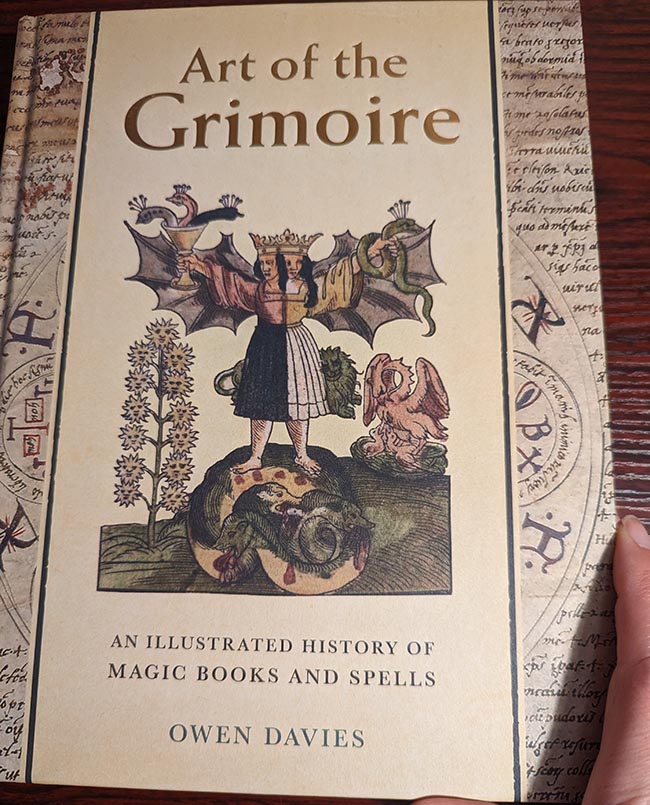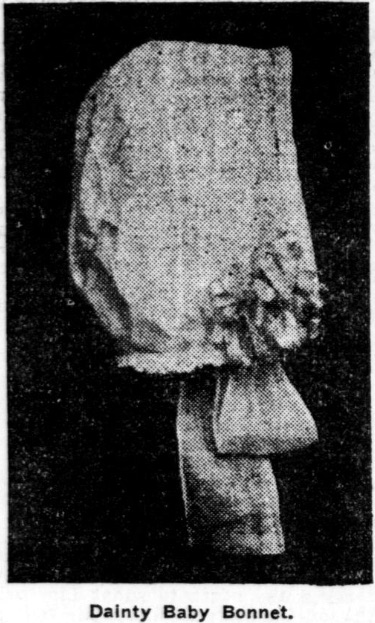
Newspapers from the early 1900s are filled with different craft ideas using the common handkerchief. On this list is the ever popular baby’s bonnet made from a simple handkerchief.
Made of Handkerchiefs
Dainty Holiday Gifts That Are Easily Made And Inexpensive
By Julia Bottomley
In casting about for gifts that are inexpensive but attractive and worthwhile, nothing will be found more satisfying than handkerchiefs. They are made in the greatest variety in size, decoration, quality and style. Manufacturers design them for many uses and consider the needs of those who convert them into accessories of dress and furnishings. Any number of the personal belongings of women and children are easily made from them and, what with the real beauty of the handkerchiefs and the hand work involved, these little gifts embody the essentials of tasteful Christmas gifts; no matter how small the cost.
Handkerchiefs for fancy work and dress accessories may be bought for less money than other equally attractive articles. They will cost from five to fifty cents each. The average for pretty, daintily finished linen ones will be in the neighborhood of twenty cents; good designs may be had for fifteen cents, showing printed borders, and a quarter will buy a good grade of linen with some embroidery. Narrow hemstitched edges or small embroidered scallops are decorative, figuring in the designs in neckwear and other accessories made from handkerchiefs. Val of Cluny lace and narrow ribbons are used with them. Lace-edged handkerchiefs are inexpensive and are especially adapted to making the neckwear fashionable at present.
Turn-over Collar And Jabot
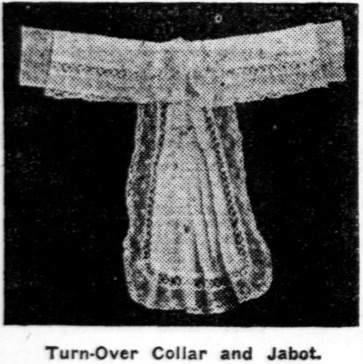
A turn-over collar and jabot is shown here, made of a sheer lawn handkerchief edged with a narrow Cluny insertion and a Val lace edging. It is very simply constructed.
Cut off from one side of a lace-edged handkerchief a strip three inches wide and divide this strip into two equal parts. Make a straight band of mull three inches wide and of the required length and hem it all round with a quarter-inch hem. Sew to one edge of this strip the two short lace-edged strips cut from the handkerchief, turning the corners to the middle of the strip. Allow the lace edges to overlap at this point. Turn in all raw edges and hem down. Lay the remainder of the handkerchief in small side plaits, forming a jabot, and sew to the lower edge of the neck band at the center.
Plain Turn-over Collar And Cuffs
To make a plain turn-ver collar and cuffs select a sheer, dainty handkerchief with narrow hemstitched hem and a little embroidery. Use a three-inch strip from one side, sewed to a straight band of mull, for the collar. Two remaining edges will make the cuffs. They should be cut a half-inch wider than the collar to allow for turning over the sleeve. Finish the raw end of each cuff with a narrow hand-sewn hem.
For a jabot, select a lace-edged or embroidered handkerchief in sheer lawn of linen or cotton. Cut the handkerchief in two pieces on a diagonal line extending from a point three inches in from one corner, to a point three inches in from the opposite corner. Sew one or both of these pieces in a scant ruffle to a straight band of insertion or fine embroidery, with their widest portions at the top of this strip. Hem the ends of the strip. Beading may be used instead of insertion, or ribbon 1-1/2 inches wide laid in fine plaits as shown in the net and lace jabot pictured here.
A Dainty Bib
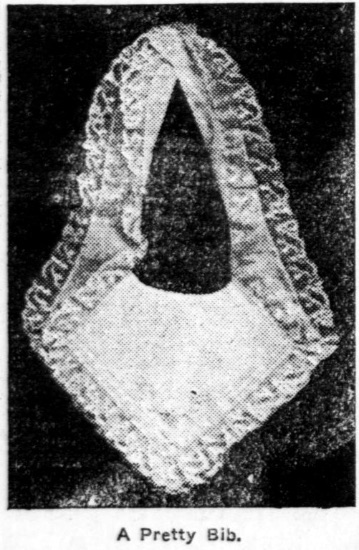
A dainty bib is shown made of the corners of a child’s sheer linen handkerchief. A narrow hemstitched border is edged with fine Val lace. the little spray of fine embroidery in the corner sets it off.
Baby Bonnet

Pretty baby bonnets are made of hemstitched sheer lawn handkerchiefs. Choose a moderately large size and run a few narrow tucks along one edge. Cut the front from a paper pattern, which may be bought at any dry goods store. The back is a little circle or a medallion of embroidery. The remaining edges of the handkerchief will furnish a finish for the tie ends.
Apron
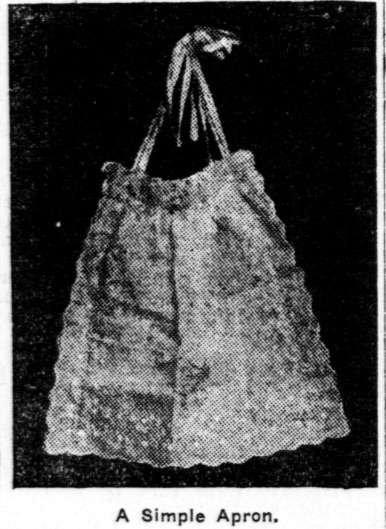
Aprons are easily made. The simplest shown here, with one corner cut away for the waist line. This corner is used to make the pocket. Sewing aprons are made of larger handkerchiefs gathered to a waist band. The bottom is turned up and stitched down to form three pockets for thread, scissors, etc.
Over Sleeves
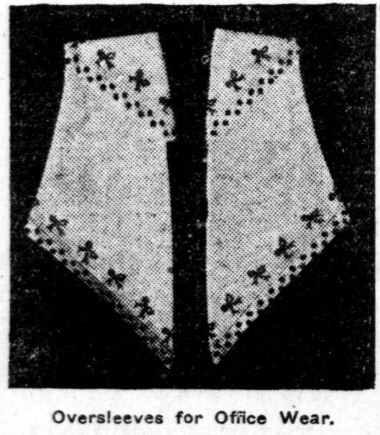
One large handkerchief will make a pair of over sleeves for office wear. Double a man’s handkerchief twice and cut the sleeves by the lower part of a coat sleeve pattern. The corners left are to be cut off and sewed to the over sleeves to form the cuffs.
Hair Receivers
One large handkerchief will make two hair receivers. Cut the handkerchief into two equal pieces. Fold down the hem corner of one of the strips and sew the hemmed and raw edges together (turning in the raw edge). This forms the front of the bag. Fold the remaining portion up and back – this forms the bag and top. Finish with a band of wide beading across the top of the bag. Run ribbon in this and trim with the ribbon bows.
Dresser Scarves And Pillow Shams
Dresser scarves, pillow shams and table covers are made by setting small handkerchiefs together with lace insertion. They may be edged with lace.
Handkerchief Cases
Handkerchief cases are made by folding three corners of a fancy handkerchief to the center and tacking them together. Sew a small pearl button here. Place a little loop covered with a bow of baby ribbon on the other corner.
Laundry Bag
Laundry bags are pretty made of two handkerchiefs cat-stitched together on three sides. A tape casing is sewed inside the top and baby ribbon run in this closes the bag and serves to hang it also.
Caps
Many pretty caps are made from handkerchiefs. Dusting caps are made by sewing a tape casing to large printed cotton handkerchiefs (men’s) and running in an elastic. The corners are turned up and tacked to place. Breakfast caps are lace trimmed and decorated with ribbon bows.
The pretty little gifts will cost, all told, from fifteen to fifty cents each – some less and others a little more. Those on which lace and ribbon are used in quantities are still inexpensive as compared with equally good gifts of other kinds.
Source: The Bourbon news. (Paris, Ky.), 19 Dec. 1911.

